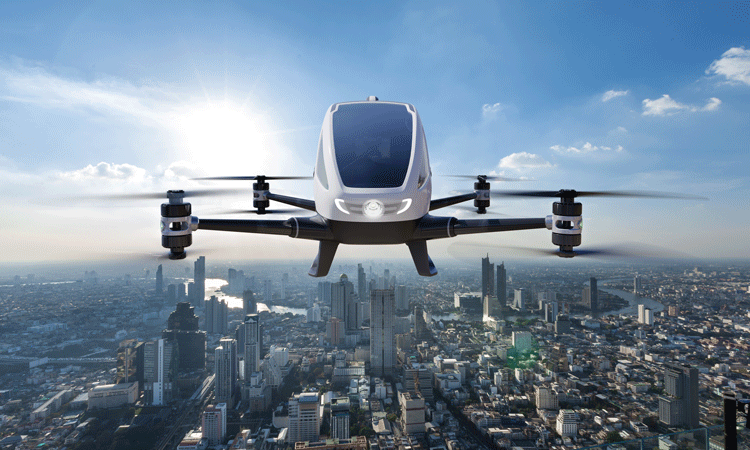The future of urban air mobility and why it is taking off
- Like
- Digg
- Del
- Tumblr
- VKontakte
- Buffer
- Love This
- Odnoklassniki
- Meneame
- Blogger
- Amazon
- Yahoo Mail
- Gmail
- AOL
- Newsvine
- HackerNews
- Evernote
- MySpace
- Mail.ru
- Viadeo
- Line
- Comments
- Yummly
- SMS
- Viber
- Telegram
- Subscribe
- Skype
- Facebook Messenger
- Kakao
- LiveJournal
- Yammer
- Edgar
- Fintel
- Mix
- Instapaper
- Copy Link
Posted: 25 October 2023 | Chris Summers | No comments yet
In this exclusive article, Chris Summers, IT Project Manager for Austin-Bergstrom International Airport, writes about the importance of Urban Air Mobility (UAM/AAM), how it can lessen the carbon impact of flying, and help deliver medical essentials, and people, to their destinations quicker.


Understanding Urban/Advanced Air Mobility
What is UAM/AAM? It stands for Urban or Advanced Air Mobility. This transportation sector is projected to grow from $5 billion in 2023 to over $23 billion globally by 2028, according to industry reports. Several factors are expected to drive this growth. These include a rise in demand for short-range routes, advances in batteries and electric propulsion systems and the sustained efforts to reduce aviation’s carbon footprint and operational costs.
Growing urbanisation, increasing traffic congestion, and the need for smarter and more sustainable transportation solutions are some of the major factors propelling this market forward. The wide availability of UAM is another reason as to why this sector is taking off. There are many use cases for this unique form of transit. The most obvious and most likely to be the fastest growing segment, is the air taxi service. The massive urbanisation of our cities over the next 20 years will only exacerbate the existing gridlock congestion of surface vehicles. Using an air taxi to get from one urban centre to another in a matter of minutes, instead of hours of wasted time in traffic, will be of huge interest to many people.
The second, and perhaps most alluring, is the seamless point-to-point passenger journey. Imagine being able to, with a single app, book a rideshare to a vertiport within two to three miles of your home and include the air taxi ride to the airport. Let’s also say that you can include your airline tickets and hotel, and then the air taxi/rideshare to the hotel (and then back to the airport and home again). Doing all this within the same app would be the nirvana of passenger experience.
What is vertical take-off and landing (VTOL)?
So, what is a vertical take-off and landing (VTOL)? These vehicles themselves are akin to the helicopters of today but with several significant differences. The new generation of VTOL aircraft act like the take-off and landings of a helicopter today, with some then transitioning to horizontal flying, like an airplane. These new vehicles, however, are vastly different from helicopters. First off, the vast majority are pure electric, so there is no chance of polluting diesel or jet fuel! There are some vehicle designs that use hydrogen fuel cells and a smaller number of electric/fuel hybrid designs at various stages of development. Secondly, instead of a single blade propeller and tail rotor, they use between four to 12 smaller blades.
This is the key difference between the VTOL and helicopters. The smaller and greater number of blades means that more lift can be created and with much less noise. Being electric (or hydrogen), the motor is as quiet as an electric car, compared to the noise of a polluting combustion engine. They vary in size, permitting between four to nine passengers (plus the pilot) and can travel between 40 and 300 miles. They also come in three varieties: autonomous (self-flying), semi-autonomous (auto-pilot assist) and fully human piloted.
Because they are so quiet, the new vertiport transit hubs can be placed much closer to residential and office centres. The initial cost for this taxi service will vary, but the industry is pitching that the initial ticket price be in the range of a premium ride share. This will attract innovators and early adopters and help eventually drive down costs in the years ahead.
The benefits of VTOL for the wider ecosystem
Why is this a big deal? If you look at the agreement recently signed between the State of Florida and the international infrastructure corporation Ferrovial, which agreed to build 20 vertiports across Florida by the end of the decade, you can see that some forward-looking agencies are embracing this technology now and are preparing for the next generation of mass transit. The U.S. Federation, the State and local governments are already writing policies, procedures, and regulations for these vehicles so that there will be no delays when they have passed airworthiness certifications in 2024/2025 and can begin to carry passengers.
At first, some of the electric vertical take-off and landing vehicles (eVOTLs) will be using some of the regional airports or one of thousands of general aviation airports around the country. The economic boom these regional and general aviation airports will see in the next decade is tremendous. Just think of all the infrastructure and jobs that will be created to support this booming sector. From wind and solar electric generation to micro grid and battery backup, to new passenger lounges and airfield renovations, the list is virtually endless.
Of course, while just getting from home to the airport or downtown is convenient, other possibilities exist too and help to serve outlying rural areas for cargo and move people rapidly to more urbanised work centres. When a three-hour bus ride to work reduces to a 20-minute air taxi, rural and urban areas can become more tightly interconnected. Delivering medical evacuation and rapid organ delivery across rugged terrain or geographic barriers like mountains, canyons, islands, bays, lakes, and rivers in mere minutes (instead of hours on surface roads and bridges), this could mean life and death for passengers.
The organisations changing the landscape
So, who is leading the charge across the world and North America? There are many emerging companies across the globe. Many of these startups have some heavy hitting partners on board. Vertical Aerospace and American Airlines, Joby, Toyota, Delta Airlines, Eve/Embraer, Wisk, Boeing, LiIium GmbH, and Supernal are some of the top teams in the world. Then there is the $131 million USAF contract with Joby to supply e-VTOL air taxis.
The Federal Aviation Administration (FAA) recently released an updated concept of operations plan for UAM. Under the blueprint, UAM operations will begin at a low rate with air taxis flying much as helicopters do today. They’ll use existing routes and infrastructure, such as helipads and early vertiports. Pilots will communicate with Air Traffic Controllers where required.
A note on the future of UAM
As the number of operations increases, air taxis are expected to fly in corridors between major airports and vertiports in city centres. The complexity of the corridors could increase over time from a single one-way path to routes serving multiple flows of aircraft, flying in both directions. Over time, these corridors could link an increasing number of routes between vertiports.
This represents a significant increase in air traffic in a very short amount of time. While aviation currently only represents 2-3% of global CO2 emissions, airports are still looking to reduce their carbon footprint. Several methods include offering sustainable aviation fuel (SAF) to their airline partners and to recycle and compost as much as possible from not only ground operations but also from airline partners. Hydrogen fuel cells are also being tested today. Every little bit helps.
However, most of the VOTLs will be electric and will help take some of the load from short-haul regional air traffic, thereby further reducing the CO2 impact. As electrification expands and increasingly becomes the norm in airport operations you will see ground vehicle fleets and support equipment also going electric. Forward-thinking airports are already setting up and installing their own micro-grids of renewable energy.


Related topics
Advanced air mobility (AAM), Autonomous Technology, Emissions, New technologies, Passenger experience and seamless travel, Sustainability
Related airports
Austin-Bergstrom International Airport, Austin-Bergstrom International Airport (ABIA)


















